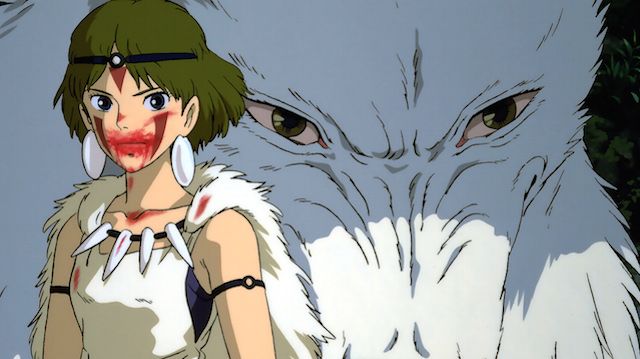Studio Ghibli feels as much a part of my childhood as the likes of Disney and Pixar. The many worlds they have created over the years have stuck with me throughout my adult life, and I often think back on them with child-like glee. They share the same otherworldly magic. They are mystical, expansive worlds that feel like extensions of our own. Forests of ancient gods and demons, verdant vistas and fantastical cities that seem anything if not real, owing to their foundation within Japanese and European culture.
Studio Ghibli and its transcendent worlds are the brainchild of Hayao Miyazaki, Isao Takahata and Toshio Suzuki, who together founded the animation studio in 1985. Studio Ghibli has produced some of the highest grossing and popular animated films in Japan, including the award-winning Spirited Away (2001), Howl’s Moving Castle (2005) and Ponyo (2008).
The word Ghibli translates to ‘hot, dry wind’ or ‘hot desert wind’, and was chosen by Myazaki to denote his studio blowing new wind through the anime industry. To his credit, he did just that. The success of Myazaki’s first written and directed film, Nausicaä of the Valley of the Wind (1984), introduced themes that were carried forward in subsequent films. It opens with a barren wasteland, dust swirling in the wind; riders transported by giant ostrich birds come into view. You’re drawn closer into a copse of trees, covered in fungus and bulbs that spew spores and webby vegetation. Beneath it all we see a structure, not of wood, but stone and mortar. Beneath the suffocating foliage, what might have been mistaken for branches are in fact the arms of a broken-down windmill. Inside has fared no better; tangled vines wrap around the bones of a body; and we see the remnants of a home decaying around it. This is Earth, one thousand years from now after the collapse of the industrial world. This is Studio Ghibli.
Establishing magical, mystical worlds on the foundation of the ordinary that deliver strong messages on concepts like environment, industrialism, innocence and childhood is the métier of classic Ghibli. These themes play a pivotal role in the narratives. Where the moral of the story might focus on an individual character’s growth or lesson they learn, Studio Ghibli takes the approach of weaving grander commentary on the world. Portraying a fight between progression and preservation, its worlds are filled with gods of the forest and the land, corrupted by the industries of man that turn them into monsters or demons. In Spirited Away the young girl Chihiro is ordered to clean a ‘stink spirit’ that has wandered into the bathhouse. She discovers the spirit has a “thorn” in its side, and yanks out first a bicycle then other rubbish, which piles into the overflowing water, contaminating it. It is an unsubtle commentary on the industrialised world.
The magic of Studio Ghibli’s films is often ambiguous and unexplained.
The same is true of Princess Mononoke (1997), with the balance between humans and animals becoming disturbed as human industry uproots the trees, extracts iron from the ground and uses it to kill the animals trying to take back their home. In Ponyo, the battle for the land is replaced with the battle of the sea as Fujimoto, an underwater wizard, seeks to restore the seas and wipe out the humans who pollute it. In Howl’s Moving Castle, Miyazaki comments on the damage inflicted from war, and how war turns men into monsters. These messages are at times quite literal, and Japan’s 20th century history is inextricable from them.
These themes might seem serious and a little dark on the surface, but they are another way to draw us in and anchor us to their magical, fantasy worlds. Ponyo, for instance, depicts flooding and is the portrayal of a small suburban town going through a natural disaster. Miyazaki is known for adding scenes of flight into his works, and they are prevalent in nearly all of Studio Ghibli’s films. From simple scenes of birds soaring to the more magical, like Howl chaperoning Sophie through the morning sky, high above crowds and catcalling soldiers.
Myazaki manages to capture that child-like dream, that human wish to be able to walk on air. Watching a Studio Ghibli film is to be in awe of these moments; to feel the wonder alongside the characters. The animation of the wind running through their hair or the expansive vistas and horizons that seem to go on forever; Ghibli captures that feeling of adventure. There are moments of quiet to transport you into its world. In Spirited Away the train tracks, flooded by monsoon rain, are transformed from a product of industry into an expansive ocean Chihiro must cross. It’s like a dream.
These flights of fantasy, however, are not where Studio Ghibli stands out from other animated film studios. If other films take the ordinary and turn it into the fantastical, Studio Ghibli takes the fantastical and makes it ordinary. The way Miyazaki draws you into the world isn’t in the spectacle of the scenes, it’s capturing the mundane moments so perfectly. In Howl’s Moving Castle we not only marvel at the mechanics of a magical moving castle, but also at the dirty, cluttered interior that seems anything but magical. Howl’s hoarder’s den is a collection of dirty dishes, magical tomes and potions, and dust. It’s a dump. An entire scene is dedicated to Sophie cleaning, as bugs scutter in fear of hot water and broom, or using the scary and powerful fire demon Calcifer to cook a deliciously animated breakfast. Ponyo’s infatuation with ham, or the simple pleasures of drinking milk with honey while a storm rages outside, are some of the everyday charms that fill Ghibli’s extraordinary worlds.
The magic of Studio Ghibli’s films is often ambiguous and unexplained. We never really understand the nature of how spells work. There are no set rules; we cannot comprehend the likes of Totoro from My Neighbour Totoro other than he is a spirit that follows the two protagonists as he guides them to their sick mother. Like the spirits of Princess Mononoke or Baba Yaga in Spirited Away, we cannot comprehend them or what they are — but they do things like visit a bath to rest and relax, and to wash away their troubles. In Castle in the Sky (1986), we don’t need to understand how or why there is a floating city in the clouds except that it is a spectacle, and a goal at the end of a grand adventure for our heroes to chase.
Miyazaki doesn’t get caught up in the details — or perhaps chooses to omit them. This is most commonly referred to as ‘soft worldbuilding’, whereby the fundamentals of the world, character, and plot can be subjectively inferred, with each viewer obtaining something potentially different and unique from their experience and coming to varied conclusions. Take, for example, the character of No-Face from Spirited Away. We are never told much about him, other than that he is a troublemaker. But we are shown through his actions a lot about his character. This has led to numerous theories and discussions over the years about what he is, what his motivations are, and what he could represent.
Going back to the magic, a lot of what can be inferred is that the systems in the films where magic is present rely on a give-and-take, a trade, in which one sacrifices one’s humanity for power. We see this in Howl’s Moving Castle, in Spirited Away and Ponyo. Magic comes at a price. The films seem to say that forsaking magic will return our characters to normal, and that dealing with demons and spirits can corrupt. It all sort of ties together.
The way Miyazaki draws you into the world isn’t in the spectacle of the scenes, it’s capturing the mundane moments so perfectly.
This brings us to what has inspired these themes of nature and purity. Nearly all of Myazaki’s works are heavily influenced by Japan’s native belief system of Shinto, a tradition in which animism is attributed to natural features like rivers and mountains. The themes of opposition to war and idealisation of nature are all prevalent in Myazaki’s works, but nowhere is this more apparent than in Princess Mononoke. The film explores the relationship between humans and nature, where “man and beast lived in harmony”. The gods and spirits of the forest represent life and purity, heavily reminiscent of Shinto. In the film, mankind has moved away from this prelapsarian ideal to the industrial age; ravaging the sacred spaces of the spirits for resources, which leads to the spirits’ corruption. The Boar God, mistaken for an evil demon that attacks a village in the opening scene, is in fact poisoned by an iron ball from human guns. Corrupted by hate and rage, his curse spreads and infects the protagonist Ashitaka. Ashitaka must face off against Jiko-bō, a greedy hunter, and Lady Eboshi, the headswoman of ‘Irontown’; who, for their own selfish reasons, look to defy the gods by killing the king of the spirits. In Howl’s Moving Castle, the Witch of the Waste is described as a woman “who was processed by a demon of greed, which consumed her body and soul.”
In Castle of the Sky, we ponder on the amazement of the castle: what kind of people live up there? How advanced were their civilisations? What can we discover and learn from them? (Spoilers follow). It’s only when Sheeta and Pazu land and finally get to see what lies inside do we realise that the people who could make a city fly with science and magic were felled by their own arrogance and ambition for war. The city itself, once thought of as a wonder, is in fact a weapon to destroy their enemies. Those who survived fled Laputa to the world below and lived among the people. All that remains are the machines; automatons who walk masterless and free, tending the gardens that have grown untamed. Nature has claimed these man-made machines.
The films seem to say that forsaking magic will return our characters to normal, and that dealing with demons and spirits can corrupt.
In an interview, Mayazaki describes his filmmaking process as “a lid is opened and very different ideas and visions are liberated. I should not handle a scene in a certain way for the sake of the audience.” Myazaki wants his audience to discover the purpose of his films for themselves, which can come in many different forms to many different people. As has been shown, Myazaki does take his inspirations from certain aspects of life, but lets his audience investigate and discover the message and meaning. It means everyone’s experience is unique and what makes Studio Ghibli films so beloved by so many.
Hayao Miyazaki has in many ways shaped the legacy of Studio Ghibli and its films. While not dismissing the amazing work of Isao Takahata, who co-founded the studio, and Toshio Suzuki, who produced and published many of Ghibli’s movies, I don’t think Studio Ghibli would be what it is without Miyazaki. It is his work that has made these worlds so immersive and timeless, and it’s sad that we won’t get any more of Miyazaki. He is set to go into retirement, after finishing his final film How do you live? This is meant to be a homage to his grandson, and as yet has no release date.
I love Studio Ghibli and I love their films. They were my gateway into the world of anime, as I’m sure they were for many others. The films are a legacy that will outlast the studio itself, and have touched the hearts of many. Not all of them are classics and everyone will have their favourites; for me, that will always be Howl’s Moving Castle. Nothing else feels as fantastical and wondrous as watching Sophie’s adventure through the world Studio Ghibli adapted from Diana Wynne Jones’ 1986 novel. As I’ve been writing this article and watching more of their films for the first time, I’ve been appreciating the other titles that I previously wouldn’t have watched. Despite their differences, they still carry that same magic that doesn’t fade — no matter how many times you visit them.



